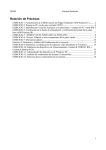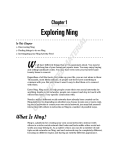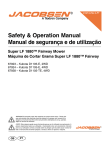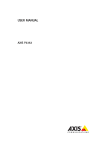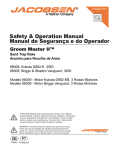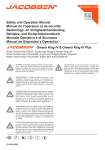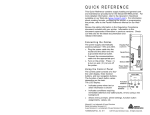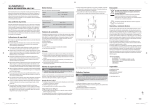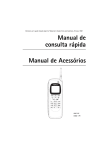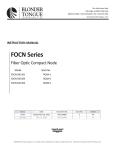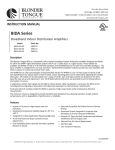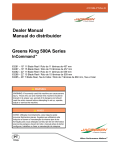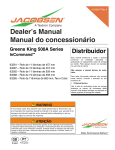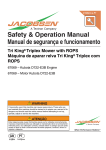Download warning - Jacobsen
Transcript
2811456-PT (rev.0) Safety & Operation Manual Manual de segurança e de utilização Greens King IV & Greens King IV Plus Model: Greens King IV 62287 - Engine type: Briggs & Stratton Vanguard Model: Greens King IV Plus 62288 - Engine type: Briggs & Stratton Vanguard Model: Greens King IV Plus 62289 - Engine type: Kubota D662-EB Modelo: Greens King IV 62287 - Motor: Briggs & Stratton Vanguard Modelo: Greens King IV Plus 62288 - Motor: Briggs & Stratton Vanguard Modelo: Greens King IV Plus 62289 - Motor: Kubota D662-EB WARNING: If incorrectly used, this machine can cause severe injury. Those who use and maintain this machine should be trained in its proper use, warned of its dangers and should read the entire manual before attempting to set up, operate, adjust or service the machine. ATENÇÃO: Esta máquina pode causar ferimentos graves se for utilizada incorrectamente. A pessoa responsável pela sua utilização e manutenção deve ser previamente instruída para a sua utilização correcta, avisada sobre os perigos que ela pode causar e deve ler todo o manual antes de tentar preparar, conduzir, afinar ou reparar a máquina. GB PT RJ 100 012003 CONTENTS 1 2 2.1 2.2 3 3.1 4 4.1 4.2 CONTENTS SAFETY Operating Safety .................................................. 3 Important Safety Notes ........................................ 4 DECALS Decals .................................................................. 5 CONTROLS Icons .................................................................... 6 Control Descriptions ............................................ 8 5 5.1 5.2 5.3 5.4 5.5 5.6 5.7 5.8 5.9 5.10 OPERATION Daily Inspection ................................................... 9 OPC System ........................................................ 9 Operating Procedures ....................................... 10 Starting .............................................................. 11 Stopping / Parking ............................................. 11 To Drive / Transport ........................................... 12 Towing / Trailering ............................................. 12 Hillside Operation .............................................. 12 Mowing .............................................................. 13 Daily maintenance ............................................. 14 Proposition 65 Warning Engine exhaust from this product contains chemicals known to the State of California to cause cancer, birth defects, and other reproductive harm © COPYRIGHT 2000, TEXTRON INC. “All rights reserved, including the right to reproduce this book or portions thereof in any form”. All information in this publication is based on information available at time of approval for printing. Textron Turf Care And Specialty Products reserves the right to make changes at any time without notice and without incurring any obligation. LITHO IN U.S.A. 5-2000 GB-2 SAFETY 2 2.1 2 SAFETY OPERATING SAFETY ______________________________________________________ ! WARNING EQUIPMENT OPERATED IMPROPERLY OR BY UNTRAINED PERSONNEL CAN BE DANGEROUS. Familiarize yourself with the location and proper use of all controls. Inexperienced operator’s should receive instruction from someone familiar with the equipment before being allowed to operate the machine. 1. Safety is dependent upon the awareness, concern and prudence of those who operate or service the equipment. Never allow minors to operate any equipment. 8. Never operate equipment that is not in perfect working order or is without decals, guards, shields, discharge deflectors or other protective devices securely fastened in place. 2. It is your responsibility to read this manual and all publications associated with this equipment (Parts and Maintenance Manual, Engine Manual, accessories and attachments). If the operator can not read English it is the owner’s responsibility to explain the material contained in this manual to them. 9. Never disconnect or bypass any switch. 3. Learn the proper use of the machine, the location and purpose of all the controls and gauges before you operate the equipment. Working with unfamiliar equipment can lead to accidents. 4. Never allow anyone to operate or service the machine or its attachments without proper training and instructions; or while under the influence of alcohol or drugs. 5. Wear all the necessary protective clothing and personal safety devices to protect your head, eyes, ears hands and feet. Operate the machine only in daylight or in good artificial light. 6. Inspect the area where the equipment will be used. Pick up all the debris you can find before operating. Beware of overhead obstructions (low tree limbs, electrical wires, etc.) and also underground obstacles (sprinklers, pipes, tree roots, etc.) Enter a new area cautiously. Stay alert for hidden hazards. 7. Never direct discharge of material toward bystanders, nor allow anyone near the machine while in operation. The owner/operator can prevent and is responsible for injuries inflicted to themselves, to bystanders and damage to property. 10. Carbon monoxide in the exhaust fumes can be fatal when inhaled. Never operate the engine without proper ventilation. 11. Fuel is highly flammable, handle with care. 12. Keep the engine clean. Allow the engine to cool before storing and always remove the ignition key. 13. Disengage all drives and engage parking brake before starting the engine (motor). Start the engine only when sitting in operator’s seat, never while standing beside the unit. 14. Equipment must comply with the latest federal, state, and local requirements when driven or transported on public roads. 15. Never use your hands to search for oil leaks. Hydraulic fluid under pressure can penetrate the skin and cause serious injury. 16. Operate the machine up and down the face of the slopes (vertically), not across the face (horizontally). 17. To prevent tipping or loss of control, do not start or stop suddenly; reduce speed when making sharp turns. Use caution when changing direction on slopes. 18. Keep legs, arms and body inside the seating compartment while the vehicle is in motion. This machine is to be operated and maintained as specified in this manual and is intended for the professional maintenance of specialized turf grasses. It is not intended for use on rough terrain or long grasses. GB-3 2 SAFETY 2.2 IMPORTANT SAFETY NOTES________________________________________________ ! This safety alert symbol is used to alert you to potential hazards. DANGER - Indicates an imminently hazardous situation which, if not avoided, WILL result in death or serious injury. WARNING - Indicates a potentially hazardous situation which, if not avoided, COULD result in death or serious injury. CAUTION - Indicates a potentially hazardous situation which, if not avoided, MAY result in minor or moderate injury and property damage. It may also be used to alert against unsafe practices. For pictoral clarity, some illustrations in this manual may show shields, guards or plates open or removed. Under no circumstances should this equipment be operated without these devices securely fastened in place ! WARNING The Interlock system on this tractor prevents the tractor from starting unless the brake lever is engaged, mower levers are off and traction lever is in neutral. The system will stop the engine if the operator leaves the seat without engaging the parking brake, setting the mower levers to off and placing traction lever in neutral. NEVER operate tractor unless the Interlock system is working. ! WARNING 1. Before leaving the operator’s position for any reason: a. b. c. d. e. Return traction lever to neutral. Disengage all drives. Lower all implements to the ground. Engage parking brake. Stop engine and remove the ignition key. 2. Keep hands, feet, and clothing away from moving parts. Wait for all movement to stop before you clean, adjust or service the machine. 3. Keep the area of operation clear of all bystanders and pets. 4. Never carry passengers, unless a seat is provided for them. 5. Never operate mowing equipment without the discharge deflector securely fastened in place. By following all instructions in this manual, you will prolong the life of your machine and maintain its maximum efficiency. Adjustments and maintenance should always be performed by a qualified technician. If additional information or service is needed, contact your Authorized Textron Turf Care And Specialty Products Dealer who is kept informed of the latest methods to service this equipment and can provide prompt and efficient service. GB-4 DECALS 3 3.1 3 DECALS DECALS _________________________________________________________________ WARNING ! CAUTION ! Never mow in transport. If lever is in transport mode, forward motion will suddenly increase when mowers are raised or sut off Inspect hoses and fabric covers daily. If worn or damaged, replace with original quality parts. 2811880 Do not use this machine on slopes greater than 12.5 . BACKLAPPING PROCEDURE 1. Engage parking brake. 2. Turn backlap lockout key to backlap position. 3. Turn all 3 backlapping knobs counter clockwise to open bypass valves. 4. Start Engine and set throttle to minimum idle speed. 5. Engage reels for backlapping. Reels may turn slowly with bypass valves open. 6. Slowly close bypass valve for reel to be backlapped until reel rotates at desired speed. 7. With extreme caution apply lapping compound with a lond handled brush. Part of 2810350 ! DANGER ! Keep hands and clothing far away from moving components to prevent personal injury. Never run an engine without proper ventilation. Read manual for further information. WARNING 1. Read operators manual. Do not allow untrained operators to use this machine. 2. Keep all shields in place and hardware securely tightened. 3. Before you clean, adjust or repair this equipment, disengage all drives, engage parking brake and stop engine. 4. Keep hands, feet and clothing away from moving parts. 5. Never carry passengers. 6. Keep bystanders away Part of 2810349 3002207 ! WARNING Reels turn when reel levers are in backlap position. Read operator's manual before backlapping. 337302 ADVERTENCIA ! 1. Leer el manual del operador. No permitir que personas no capacitadas para ello usen la máquina. 2. Mantener los escudos en su lugar y la tornilleria debidamente fijada. 3. Antes de limpiar, adjustar o reparar este equipo, desengranar todos los mandos, aplicar el freno de estacionamiento y apagar el motor. 4. Mantener las manos, los pies y la ropa alejados de las piezas en movimiento. 5. No viajar como pasajero ni llevar pasajeros en máquinas sin asiento para ello. 6. Mantenar a las demás personas alejadas. 7. Si no sabe leer inglés, solicitarle a otra persona que le lea y explique el contenido de las etiquetas y del manual de la máquina. ! WARNING To prevent burns, do not touch muffler or muffler shield. Temperatures may exceed 150 F (66 C) CAUTION Fill fuel tank to 1 inch (25mm) below filler neck. Do not overfill 361169 ! WARNING DO NOT USE FOR TOWING 361175 Torsion spring under extreme tension. Clamp may turn suddenly. To avoid injury, unwind spring by tapping on clamp while loosening nut 340586 339237 DANGER ! ! WARNING Radiator is under pressure. Remove cap slowly to avoid personal injury 340830 ! CAUTION ! To prevent injury, disengage all drives, engage parking brake and stop engine before working in machine or emptying grass catchers. 365956 ! DANGER To prevent injury: ● Always connect red battery cable to the positive (+) post FIRST and the black cable to negative (–) post LAST. ● When removing the battery always remove negative (–) cable FIRST and positive (+) cable LAST. ● Avoid contact with battery acid. ● Keep sparks and flames away from the battery. ● Do not short circuit battery posts. Do not touch frame or negative terminal when working on positive terminal. 361877 ! CAUTION To Install the battery 1. Install the battery with terminals toward frame center. 2. Secure battery to support. 3. Connect positive (+) (red) FIRST. 4. Connect negative (–) (black) LAST. To use jumper cables: 1. Stop the engine on vehicle with good battery. 2. Connect RED cable to positive (+) terminal on good battery and positive (+) terminal on discharged battery. 3. Connect the BLACK cable from negative (–) terminal on good battery to frame of vechile with discharged battery. 4. Start the engine. 336640 GB-5 4 CONTROLS 4 CONTROLS 4.1 ICONS ___________________________________________________________________ Read Manual Service Foot Brake Fast Parking Brake Engaged Slow Hour Meter Disengaged Forward Reverse Fuel Diesel P Reel Rotation Circuit Breaker Engine Throttle Mow/Lift Treadle Lower Raise Gasoline D Reel Switch Enable Engine Off Disable Run Traction Lever Start Forward 2 Transport 1 Mow Hydraulic Oil Leak Headlight N Neutral Choke Reverse Horn Glow Plug Fuse On ! Off R Reverse Coolant Temperature WARNING Never attempt to drive the tractor unless you have read the Safety and Operation Manual and know how to operate all controls correctly. Familiarize yourself with the icons shown above and what they represent. Learn the location and purpose of all the controls and gauges before operating this tractor. GB-6 CONTROLS A B C D E F G H I J K L M N O P Q R S T U V W X Y Reel Control Lever Parking Brake Lever Traction Lever Temperature Gauge (Diesel) Volt Meter Ignition Switch Mechanics (Backlap) Switch Light Switch (Optional) Fuse, Lights (Optional) Fuse, Charging Circuit Fuse, Interlock System Parking Brake Light Oil Pressure Light Throttle Choke (Gasoline) Glow Plug Switch (Diesel) Fuse, Glow Plug (Diesel) Accelerator Pedal Brake Pedal Tilt Control (GK IV Plus) Mow/Lift Pedal Hour Meter Seat Control Lever Hydraulic Cap/Dipstick Fuel Cap D A ! B 4 E WARNING 1. Read operators manual. Do not allow untrained operators to use this machine. 2. Keep all shields in place and hardware securely tightened. 3. Before you clean, adjust or repair this equipment, disengage all drives, engage parking brake and stop engine. 4. Keep hands, feet and clothing away from moving parts. 5. Never carry passengers. 6. Keep bystanders away 10 12 14 16 10 12 14 16 C 2 1 N J R ! WARNING Never mow in transport. If lever is in transport mode, forward motion will suddenly increase when mowers are raised or sut off Do not use this machine on slopes greater than 12.5 . T ! WARNING Reels turn when reel levers are in backlap position. Read operator’s manual before backlapping. K S U R G F L H I M V W O N Gas Units 3-5 P 40 Y X N Q Diesel Units GB-7 4 CONTROLS 4.2 A. CONTROL DESCRIPTIONS__________________________________________________ Reel Control Lever - Used to operate the cutting units. Push lever(s) forward for forward rotation. Pull lever(s) back for Reverse rotation. All three levers must be in OFF position to start engine O. Choke (Gas Units) - Pull the choke control knob upwards to close the choke plate when starting a cold engine. A warm engine may not require “Choking” to start. B. Parking Brake Lever - Pull back to engage and push forward to disengage parking brake. Always disengage parking brake slowly. Parking brake must be engaged to start engine. P. C. Traction Lever - Four Positions: TRANSPORT (2), MOW (1), NEUTRAL (N) and REVERSE (R). Traction lever must be in NEUTRAL position to start engine Q. Fuse, Glow Plug (Diesel Units) - 40 Amp fuse, protecting glow plug circuit. D. Temperature Gauge (Diesel Units) - Indicates engine coolant temperature. Normal operating temperatures should be 185° - 195° F (85° - 91° C). E. Volt Meter - Used to monitor battery condition. During normal operation, volt meter needle should never be in the red area. F. Ignition Switch - Used to start the engine. To prevent unauthorized operation, remove the ignition key when tractor is not in use G. Mechanic’s (Backlap) Switch - Used to hone the reels and bedknife. H. Light Switch (Optional) - Used to control operation of optional light kit. I. Fuse, Lights - 20 Amp fuse, protecting light circuit. J. Fuse, Charging Circuit (Gas Units) - 20 Amp fuse, protecting charging circuit. J. Fuse, Charging Circuit (Diesel Units) - 30 Amp fuse, Protecting charging circuit. K. Fuse, Interlock System - 6 Amp fuse, protecting Interlock System. L. Parking Brake Light - Light is always on when parking brake is engaged. Do not move traction lever out of neutral, or press accelerator pedal when light is on. M. Engine Oil Pressure Light - Indicator will light if engine oil pressure drops below a safe level. Stop engine immediately, determine the cause and correct problem before restarting engine. N. Throttle - Regulates Engine Speed. Push Lever forward to increase or pull lever back to decrease engine speed. GB-8 Glow Plug Switch (Diesel Units) - Used to energize the glow plugs. Push toggle switch forward and hold for 3 - 5 seconds, then release the switch. Do not depress the switch for more than 5 seconds. R. Accelerator Pedal - Used to control speed of the tractor. Do not depress pedal if parking brake light (L) is on. Remove foot from pedal, the accelerator pedal will return to neutral, and the machine will stop. The self braking action is in forward direction only. S. Brake Pedal - Used to stop tractor when traveling in REVERSE. Remove foot from accelerator and depress brake pedal T. Tilt Control (Greens King IV Plus Units) - Turn to unlock tilt control lever and adjust steering wheel to desired angle then lock steering column in position. U. Mow/Lift Pedal - Used to lift or lower the cutting units. Depress and hold front of pedal to lower cutting units, or depress and hold rear of pedal to raise cutting units Note: When operating the mow/lift pedal, keep the pedal depressed until the cutting units have been fully lowered or raised, then release the pedal V. Hour Meter - Used to time maintenance intervals or mowing operations. The meter operates only when ignition key is in RUN position W. Seat Control Lever - Used to adjust position of seat. Pull lever forward and adjust seat to comfortable position. Then release lever X. Hydraulic Cap/Dipstick - Used to check level of hydraulic fluid in tank. Level should always be at full mark on dipstick Y. Fuel Cap - Remove cap to add fuel, or check fuel level in tank. Always replace cap tightly. OPERATION 5 5.1 OPERATION DAILY INSPECTION ________________________________________________________ CAUTION ! The daily inspection should be performed only when the engine is off and all fluids are cold. Lower mowers to the ground, engage the parking brake, Stop engine and remove ignition key. 1. Perform a visual inspection of the entire unit, look for signs of wear, loose hardware, and missing or damaged components. Check for fuel or oil leaks to ensure connections are tight and hoses and tubes are in good condition. 5.2 5 2. Check the fuel supply, radiator coolant level, crankcase oil and air cleaner indicator. All fluids must be at the full level mark with engine cold. 3. Make sure all mowers are adjusted to the same cutting height. 4. Check tires for proper inflation. 5. Test the Interlock system. Note: For more detailed maintenance information, adjustments and maintenance/lube charts, see the Parts & Maintenance manual. Interlock System _________________________________________________________________________ Test 1: Represents normal starting procedure. The operator is seated, parking brake is engaged, the traction lever is in neutral, and the reel levers are OFF. The engine should start. 1. The Interlock system prevents the engine from starting unless the parking brake is engaged, the traction lever is in neutral and the reel levers are OFF. The system also stops the engine if the operator leaves the seat with the reel levers ON, traction lever out of NEUTRAL, or parking brake DISENGAGED. ! Test 2: The engine must not start if the reel lever is in FORWARD or REVERSE. Repeat test for each reel lever and lever position. WARNING Test 3: The engine must not start if the parking brake is DISENGAGED. Never operate equipment with the Interlock system disconnected or malfunctioning. Do not disconnect or bypass any switch. Test 4: The engine must not start if traction lever is not in neutral. Repeat test for each position of lever. 2. Perform each of the following tests to insure the Interlock system is functioning properly. Stop the test and have the system inspected and repaired if any of the tests fail as listed below: Test 5: Start the engine in the normal manner then turn reel lever ON and lift your weight off the seat. Repeat test for each reel lever and lever position. ★ Test 6: Start the engine in the normal manner then disengage parking brake and lift your weight off the seat. ★ ● the engine does not start in test 1; ● the engine does start during tests 2,3 or 4; ● the engine continues to run during tests 5 or 6. Test 7: Start the engine in the normal manner then shift traction lever out of neutral and lift your weight off the seat. Repeat test for each lever position ★ 3. Refer to the chart below for each test and follow the check (✔) marks across the chart. Shut engine off between each test. Interlock System Check Test Operator Seated Yes No Parking Brake Engaged Traction Lever in Neutral Disengaged Yes 1 ✔ ✔ ✔ 2 ✔ ✔ ✔ 3 ✔ 4 ✔ 5 ✔ ★ 6 ✔ ★ 7 ✔ ★ ✔ On ✔ ✔ ✔ ✔ Engine Starts Off Yes ✔ ✔ ✔ ✔ ✔ ✔ No Reel Levers ✔ ✔ ✔ ✔ ✔ ✔ ✔ ✔ No ★ ✔ ★ ✔ ★ ★ Lift your weight off seat. The engine will shut down. GB-9 5 5.3 OPERATION OPERATING PROCEDURES_________________________________________________ ! CAUTION To prevent injury, always wear safety glasses, leather work shoes or boots, a hard hat, and ear protection. 1. Under no circumstances should the engine be started without the operator seated on the tractor. 2. Do not operate tractor or attachments with loose, damaged or missing components. Whenever possible mow when grass is dry. 3. First mow in a test area to become thoroughly familiar with the operation of the tractor and control levers. Never operate the reels unless they are mowing grass. Heat will develop between the bedknife and reel and damage the cutting edge. 4. Study the area to determine the best and safest operating procedure. Consider the height of the grass, type of terrain, and condition of the surface. Each condition will require certain adjustments or precautions. Only use accessories and attachments approved by Textron Turf Care And Specialty Products 5. Never direct discharge of material toward bystanders, nor allow anyone near the machine while in operation. The owner/operator is responsible for injuries inflicted to bystanders and/or damage to their property. ! CAUTION Before mowing, pick up all debris such as rocks, toys and wire which can be thrown by the machine. Enter a new area cautiously. Always operate at speeds that allow you to have complete control of the mower. 6. Use discretion when mowing near gravel areas (roadway, parking areas, cart paths, etc.). Stones discharged from the implement may cause serious injuries to bystanders and/or damage the equipment. 7. Always turn reel switch off to stop blades when not mowing. 8. Disengage the drive motors and raise the reels when crossing paths or roadways. Look out for traffic. 9. Stop and inspect the equipment for damage immediately after striking an obstruction or if the GB-10 machine begins to vibrate abnormally. Have the equipment repaired before resuming operation. ! WARNING Before you clean, adjust, or repair this equipment, always disengage all drives, lower implements to the ground, engage parking brake, stop engine and remove key from ignition switch to prevent injuries. 10. Slow down and use extra care on hillsides. Read Section 5.8. Use caution when operating near drop offs. 11. Look behind and down before backing up to be sure the path is clear. Use care when approaching blind corners, shrubs, tress or other objects that may obscure vision. 12. Never use your hands to clean cutting units. Use a brush to remove grass clippings from blades. Blades are extremely sharp and can cause serious injuries OPERATION 5.4 5 STARTING________________________________________________________________ IMPORTANT: Do not use starting assist fluids. Use of such fluids in the air intake system may be potentially explosive or cause a “Runaway” engine condition and could result in serious engine damage. 1. Make sure fuel shut off valve is completely open and the tow valve is closed. 2. Sit in operator’s seat, make sure the reel levers (A) are OFF, parking brake (B) is engaged and traction lever (C) is in neutral. 3. Move throttle lever (N) between 1/8 to 1/2 throttle. Turn ignition switch (F) to RUN b. Turn Ignition switch to START position and release as soon as engine starts. Do not hold the key in the start position for more than 15 seconds. 6. Allow the engine to become warm and properly lubricated before operating at high RPM. A B ! WARNING 1. Read operators manual. Do not allow untrained operators to use this machine. 2. Keep all shields in place and hardware securely tightened. 3. Before you clean, adjust or repair this equipment, disengage all drives, engage parking brake and stop engine. 4. Keep hands, feet and clothing away from moving parts. 5. Never carry passengers. 6. Keep bystanders away 10 12 14 16 10 12 14 4. Gas Units. 16 2 C 1 N a. Pull choke lever (O) to fully close choke plate. R ! WARNING Never mow in transport. If lever is in transport mode, forward motion will suddenly increase when mowers are raised or sut off b. c. Turn Ignition switch (F) to START position and release as soon as engine starts. Do not hold the key in the start position for more than 15 seconds. 5.5 ! WARNING Reels turn when reel levers are in backlap position. Read operator’s manual before backlapping. F Slowly push choke lever in to open choke plate. 5. Diesel Units. a. Do not use this machine on slopes greater than 12.5 . Figure 5A Push glow plug switch forward for 5 seconds maximum, then release the switch. The colder the temperature, the longer it will take to energize the glow plugs. STOPPING / PARKING ______________________________________________________ To stop: Remove your foot from accelerator pedal. The tractor will automatically brake when the accelerator pedal returns to neutral. Always engage the parking brake before leaving your machine. If an emergency arises and the tractor must be parked in the area of operation, follow the guidelines outlined by the grounds superintendent. If the tractor is parked on an incline, chock or block the wheels. To park the tractor under normal conditions: 1. Disengage the reel levers, raise the implements and move away from the area of operation. 2. Select a flat and level area to park. a. Release accelerator pedal to bring the tractor to a complete stop. b. Disengage all drives, lower implements to the ground, reduce throttle to slow and allow engine to operate at no load for a minute. 3. Engage parking brake, stop the engine and always remove the ignition key. GB-11 5 5.6 OPERATION TO DRIVE / TRANSPORT____________________________________________________ Read and follow all safety notes contained in this manual when driving or transporting tractor. Refer to Section 5.3 for general operating instructions. When operating in reverse look behind you to ensure you have a clear path. Important: If this tractor is driven on public roads, it must comply with federal, state and local ordinances. Contact local authorities for regulations and equipment requirements. 5.7 1. Disengage all drives and raise implements to the transport position when driving to and from the area of operation. 2. Disengage parking brake and move traction lever to “TRANSPORT”. Depress accelerator pedal slowly. ! CAUTION To prevent tipping or loss of control, travel at reduced speed when making turns. TOWING / TRAILERING _____________________________________________________ If the tractor experiences problems and must be shut down and removed from the area, it should be loaded onto a trailer for transport. If a trailer is not available, the unit can be towed slowly short distances. Before towing, raise cutting units. If cutting units cannot be raised, remove them from the tractor. NOTE: Do not exceed 2 MPH (3.2 KPH) while towing. Long distance towing is not recommended. Make sure unit will not roll and release parking brake. Turn ignition switch OFF and remove key. Engage parking brake after towing. Use care when loading and unloading tractor. Fasten tractor to trailer to prevent tractor from rolling or shifting during transport. 5.8 HILLSIDE OPERATION _____________________________________________________ ! WARNING ! To minimize the possibility of overturning, the safest method for operating on hills and terraces is to travel up and down the face of the slope (vertically), not across the face (horizontally). Avoid unnecessary turns, travel at reduced speeds, stay alert for hidden hazards, and drop offs. ! CAUTION Do not operate this tractor on slopes greater than 12.5°. The tractor has been designed for good traction and stability under normal mowing conditions; however, use caution when operating on slopes, especially over rough terrain or when the grass is wet. Wet grass reduces traction and steering control. GB-12 1. Always mow with the engine at full throttle but reduce forward speed to maintain the proper cutting frequency. 2. If the tractor tends to slide or the tires begin to “mark” the turf, angle tractor into a less steep grade until traction is regained or tire marking stops. 3. If tractor continues to slide or mark the turf, the grade is too steep for safe operation. Do not make another attempt to climb, back down slowly. 4. When descending a steep slope, always lower implements to the ground to reduce the risk of tractor overturning. Correct tire pressure is essential for maximum traction. OPERATION 5.9 5 MOWING _________________________________________________________________ ! WARNING To prevent serious injuries, keep hands, feet and clothing away from cutting unit when the blades are moving. NEVER use your hands to clean cutting units. Use a brush to remove grass clippings from blades. Blades can be sharp and could cause injuries. To clear obstructions from cutting unit, disengage reel switch, engage parking brake, stop engine and remove key from ignition switch then remove obstruction. To mow: 2. Turn reel switch to ON and disengage parking brake. 3. Move throttle lever to FAST then slowly depress traction pedal to the desired mowing speed. a. For complete even cutting, overlap swaths by a few inches. b. Stop and raise the mowers to the transport position when crossing paths or roadways. Look out for traffic. 4. To remove or install the grass catchers, lower the cutting units to the ground, engage the parking brake, and shut off the engine. Tilt the grass catcher body so the front edge clears the mower frame, and slide the catcher onto or off the catcher frame. 1. Start the engine and lower the mowers to the ground. Note: To prevent damage to the reel and bedknife, never operate reels when they are not cutting grass. GB-13 5 OPERATION 5.10 DAILY MAINTENANCE _____________________________________________________ Important: For more detailed maintenance information, adjustments and maintenance/lubrication charts, see the Parts & Maintenance manual. 1. Park the tractor on a flat, level surface. Fully lower the implements to the ground, engage parking brake, stop the engine and remove key from ignition switch. 2. Grease and lubricate all points if required. To prevent fires, wash the cutting units and tractor after each use. a. Use only fresh equipment. water for cleaning your Note: Use of salt water or effluent water has been known to encourage rust and corrosion of metal parts resulting in premature deterioration or failure. Damage of this nature is not covered by the factory warranty. b. Do not use high pressure spray. c. Do not spray water directly at the instrument panel, or any electrical components. d. Do not spray water into the cooling air intake or the engine air intake. Note: Do not wash a hot or running engine. Use compressed air to clean the engine and radiator fins. 3. Fill tractor’s fuel tank at the end of each operating day to within 1 in., (25 mm) below the filler neck. Diesel Engine - Use clean, fresh #2 diesel fuel. Minimum Cetane Rating 45. Gasoline Engine - Use clean, fresh, unleaded gasoline, 85 octane minimum. 4. Handle fuel with care - it is highly flammable. Use an approved container, the spout must fit inside the fuel filler neck. Avoid using cans and funnels to transfer fuel. a. Never remove the fuel cap from the fuel tank, or add fuel, when the engine is running or while the engine is hot. b. Do not smoke when handling fuel. Never fill or drain the tank indoors. c. Never overfill or allow the tank to become empty. Do not spill fuel. Clean any spilled fuel immediately. d. Never handle or store fuel containers near an open flame or any device that may create sparks and ignite the fuel or fuel vapors. GB-14 5. Store fuel according to local, state or federal ordinances and recommendations from your fuel supplier. ! WARNING To prevent serious injury from hot, high pressure oil, never use your hands to check for oil leaks, use paper or cardboard. Hydraulic fluid escaping under pressure can have sufficient force to penetrate skin. If fluid is injected into the skin, it must be surgically removed within a few hours by a doctor familiar with this form of injury or gangrene may result. 6. Inspect hydraulic hoses and tubes daily. Look for wet hoses or oil spots and replace worn or damaged hoses and tubes before operating the machine. 7. Check the engine oil and hydraulic oil at the start of each day, before starting the engine. If the oil level is low, remove the oil filler cap and add oil as required. Do not overfill. ÍNDICE 2 2.1 2.2 3 3.1 4 4.1 4.2 SEGURANÇA Segurança no funcionamento........................... 3 Instruções importantes de segurança .............. 4 AUTOCOLANTES Autocolantes ..................................................... 5 CONTROLOS Ícones ............................................................... 6 Descrição dos controlos ................................... 8 5 FUNCIONAMENTO 5.1 Inspecção diária ............................................... 9 5.2 Sistema de bloqueio ......................................... 9 5.3 Procedimentos de utilização .......................... 10 5.4 Ligar ............................................................... 11 5.5 Parar / Estacionar ........................................... 11 5.6 Condução / Transporte ................................... 12 5.7 Rebocar / Carregamento num reboque .......... 12 5.8 Trabalho em encostas .................................... 12 5.9 Corte ............................................................... 13 5.10 Manutenção diária .......................................... 14 Aviso da Proposição 65 A exaustão do motor deste produto contém químicos conhecidos do Estado da Califórnia por causarem cancro, deficiências de nascimento e outros perigos reprodutivos © COPYRIGHT 2000, TEXTRON INC. “Todos os direitos reservados, incluindo o direito de reproduzir este material ou porções de qualquer forma.” Toda a informação nesta publicação é baseada na informação disponível na altura da aprovação para impressão. Textron Turf Care And Specialty Products reserva-se o direito de fazer alterações a qualquer altura sem aviso e sem qualquer obrigação. LITOGRAFADO NOS EUA 5-2000 PT-2 SEGURANÇA 2 2.1 2 SEGURANÇA SEGURANÇA NO FUNCIONAMENTO _________________________________________ ! ATENÇÃO O EQUIPAMENTO UTILIZADO INADEQUADAMENTO OU POR PESSOAL NÃO TREINADO PODE SER PERIGOSO Familiarize-se com a localização e com a utilização correcta de todos os comandos. Condutores sem experiência devem receber formação de alguém que já conheça o equipamento antes de serem autorizados a conduzir a máquina. 1. A segurança depende da atenção, do cuidado e da prudência das pessoas que conduzam ou prestem assistência ao equipamento. Nunca permita que menores conduzam o equipamento. 2. É da sua responsabilidade ler este manual e todas as publicações associadas a este equipamento (Manual de Peças e Manutenção, Manual do Motor, acessórios e equipamento complementar). Se o condutor não souber Inglês, o proprietário é responsável pela explicação do conteúdo deste manual. 3. Aprenda a conduzir correctamente a máquina, a localização e a finalidade de todos os comandos e mostradores antes de trabalhar com o equipamento. O trabalho com equipamentos mal conhecidos pode provocar acidentes. 4. Nunca permita que alguém conduza ou repare a máquina ou equipamentos sem possuir a formação própria e instruções correctas, ou se estiver sob a influência de drogas ou de álcool. 5. Use todo o vestuário de protecção necessário e dispositivos de protecção pessoal para proteger a cabeça, os olhos, os ouvidos, as mãos e os pés. Só conduza a máquina à luz do dia ou com boa iluminação artificial. 6. 7. Inspeccione a área onde o equipamento vai ser usado. Antes de começar a trabalhar com a máquina, recolha todos os detritos que encontrar. Tenha cuidado com obstáculos acima da cabeça (ramos de árvores a pouca altura, cabos eléctricos, etc.) e também com obstáculos no solo ou no subsolo (aspersores, tubos, raízes de árvores, etc.). Seja sempre cauteloso numa zona que desconheça. Esteja atento a perigos ocultos. Nunca vire a descarga do material para pessoas próximas nem permite que haja pessoas perto da máquina durante o trabalho. O proprietário/condutor pode evitar e é responsável por ferimentos a si mesmo, a pessoas próximas e por danos materiais. 8. Nunca trabalhe com equipamento que não se encontre em perfeito estado de funcionamento ou que esteja sem chapas de aviso, resguardos, painéis, deflectores para descarga ou outros dispositivos de protecção firmemente instalados. 9. Nunca desligue nenhum interruptor nem faça ponte sobre interruptores. 10. O monóxido de carbono nos gases de escape pode ser mortal se for inalado. Nunca deixe o motor a trabalhar sem ventilação adequada. 11. O combustível é altamente inflamável; manuseie-o com cuidado. 12. Mantenha o motor limpo. Deixe o motor arrefecer antes de guardar a máquina e retire sempre a chave da ignição. 13. Desengate todos os accionamentos e puxe o travão de estacionamento antes de ligar o motor. Ligue o motor só depois de estar sentado no banco do condutor e nunca enquanto estiver ao lado do equipamento. 14. O equipamento tem de estar em conformidade com a mais recente legislação nacional, regional e local ao ser conduzido ou transportado na via pública. 15. Nunca use as mãos para procurar fugas de óleo. O fluido hidráulico sob pressão pode penetrar na pele e provocar ferimentos graves. 16. Em taludes e declives, conduza a máquina para cima e para baixo (transversalmente) e não na horizontal. 17. Para evitar a capotagem ou perda de controlo, nunca pare nem arranque bruscamente; reduza a velocidade em curvas apertadas. Tenha cuidado em curvas apertadas em declives. 18. Mantenha as pernas, os braços e o corpo no interior da cabina durante a deslocação do veículo. Esta máquina tem de ser conduzida e assistida como se indica neste manual e destina-se à manutenção de relvados especializados por profissionais. Não é própria para terrenos grosseiros nem para erva alta. PT-3 2 2.2 SEGURANÇA INSTRUÇÕES IMPORTANTES DE SEGURANÇA ________________________________ ! Esta chamada de atenção de segurança é usado para assinalar perigos potenciais. PERIGO - Indica uma situação de perigo iminente que, se não for evitada, PROVOCARÁ a morte ou ferimentos graves. ATENÇÃO - Indica uma situação potencialmente perigosa que, se não for evitada, PODE provocar a morte ou ferimentos graves. CUIDADO - Indica uma situação potencialmente perigosa que, se não for evitada, PODE provocar ferimentos ligeiros a médios e danos materiais. Este símbolo também pode ser usado para avisar contra práticas perigosas. Para maior clareza das gravuras, algumas ilustrações neste manual podem mostrar chapas, resguardos ou placas abertas ou removidas. No entanto, em nenhumas circunstâncias poderá este equipamento ser conduzido sem esses dispositivos firmemente instalados nos seus lugares. ! ATENÇÃO O sistema de bloqueio neste tractor evita que o tractor se ligue excepto se a alavanca do travão estiver engatada, as alavancas dos cortadores estiverem desligadas e a alavanca de tracção estiver neutra. O sistema irá parar o motor se o operador deixar o assento sem engatar o travão de estacionamento, definindo as alavancas do cortador para Desligado e colocando a alavanca de tracção neutra. Nunca opere o tractor excepto se o sistema de bloqueio estiver a funcionar. ! ATENÇÃO 1. Se, por qualquer razão, tiver de sair do posto de condução: a. b. c. d. e. Retorne a alavanca de tracção para neutro. Desengate todos os comandos. Baixe todos os equipamentos para o chão. Engate o travão de estacionamento. Desligue o motor e retire a chave da ignição. 2. Mantenha as mãos, os pés e o vestuário longe de peças em movimento. Espere que todos os movimentos parem antes de limpar, afinar ou dar a assistência à máquina. 3. Mantenha a área de trabalho livre de pessoas e animais. 4. Nunca transporte passageiros se não houver banco apropriado. 5. Nunca trabalhe com equipamento de cortar a relva sem que o deflector de descarga esteja firmemente instalado no seu lugar. Se seguir todas as instruções deste manual, prolongará a vida da sua máquina e manterá o seu rendimento máximo. Afinações e trabalhos de manutenção devem ser sempre executados por técnicos qualificados. Se necessitar de informação adicional ou de manutenção, contacte o seu Agente Autorizado Textron Turf Care And Specialty Products que se mantém informado relativamente aos últimos métodos de manutenção deste equipamento e pode disponibilizar manutenção imediata e eficaz. PT-4 AUTOCOLANTES 3 3.1 3 AUTOCOLANTES AUTOCOLANTES __________________________________________________________ ATENÇÃO ! CUIDADO ! Mantenha as mãos e vestuário afastados dos componentes móveis para evitar lesões pessoais. Nunca opere um motor em local onde não haja ventilação adequada. Leia o manual para informação adicional. 2811880 Não use esta máquina em declives superiores a 12,5°. PROCEDIMENTO DE INVERSÃO DE MOVIMENTO 1. Engate o travão de estacionamento. 2. Rode a chave de bloqueio da inversão de movimento para a posição de inversão de movimento. 3. Rode os 3 botões de inversão de movimento no sentido contrário ao dos ponteiros do relógio para abrir as válvulas de derivação. 4. Ligue o motor e defina a aceleração para a velocidade mínima. 5. Engate os rolos para a inversão de movimento. Os rolos devem rodar lentamente com as válvulas de derivação abertas. 6. Lentamente, feche a válvula de derivação para que o rolo inverta o movimento até o rolo rodar à velocidade desejada. 7. Com extremo cuidado aplique o produto de polir com uma longa escova manuseada. Parte do 2810350 ! PERIGO ! Inspeccione as mangueiras e coberturas de tecido diariamente. Se estiverem desgastadas ou danificadas, substitua por peças originais de qualidade. Nunca corte durante o transporte. Se a alavanca estiver no modo de transporte, o movimento de avanço irá repentinamente aumentar quando os cortadores forem subidos ou desligados. ATENÇÃO 1. Leia o manual do operador. Não permita que operadores sem formação usem esta máquina. 2. Mantenha todos os painéis no seu lugar e todos os equipamentos bem presos. 3. Antes de limpar, ajuste ou repare este equipamento, desengate todos os comandos, engate o travão de estacionamento e pare o motor. 4. Mantenha as mãos, os pés e o vestuário longe de peças em movimento. 5. Nunca transporte passageiros. Parte do 2810349 6. Mantenha as pessoas afastadas. 3002207 ! ATENÇÃO Os rolos rodam quando as alavancas do rolo estão na posição de inversão do movimento. Leia o manual do operador antes de inverter o movimento. 337302 ! CUIDADO ! ATENÇÃO Mola de torção sob tensão extrema. O grampo pode rodar rependinamente. Para evitar lesões, desbobine a mola abrindo o grampo enquanto desaperta a porca. Para evitar queimaduras, não toque no silenciador ou na blindagem do silenciador. As temperaturas podem exceder os 66° C. 340586 339237 PERIGO ! ! ATENÇÃO O radiador está sob pressão. Retire a tampa lentamente para evitar lesões. Para evitar lesões, desengate todos os comandos, engate o travão de estacionamento e pare o motor antes de trabalhar com a máquina ou esvaziar os colectores de relva. 365956 ! CUIDADO Encha o depósito de combustível para 25 mm abaixo do gargalo de enchimento. Não encha demasiado. 361169 ! ATENÇÃO NÃO USE PARA REBOCAR 361175 ! PERIGO Para evitar lesões: Ligue sempre o cabo vermelho da bateria ao pólo positivo (+) em PRIMEIRO lugar e o cabo preto ao pólo negativo (-) em ÚLTIMO lugar. Quando remover a bateria remova sempre em PRIMEIRO lugar o cabo negativo (-) e em ÚLTIMO o cabo positivo (+). Evite o contacto com o ácido da bateria. Mantenha faúlhas e chamas afastadas da bateria. Não submeta os pólos da bateria a curto circuitos. Não toque na estrutura ou no terminal negativo quando estiver a trabalhar no terminal positivo. 361877 ! CUIDADO Para instalar a bateria: 1. Instale a bateria com os terminais no sentido do centro da estrutura. 2. Fixe a bateria no suporte. 3. Ligue em PRIMEIRO lugar o positivo (+) (vermelho). 4. Ligue em ÚLTIMO o negativo (-) (preto). Para usar cabos de ligação: 1. Desligue o motor no veículo com uma bateria em bom estado. 2. Ligue o cabo VERMELHO ao terminal positivo (+) na bateria boa e o terminal positivo (+) à bateria descarregada. 3. Ligue o cabo PRETO do terminal negativo (-) na bateria boa à estrutura do veículo com a bateria descarregada. 4. Ligue o motor. 336640 PT-5 4 CONTROLOS 4 CONTROLOS 4.1 ÍCONES__________________________________________________________________ Leia o Manual Travão de Pé de Serviço Pedal Cortar/Elevar Baixar Elevar Travão de Estacionamento Disjuntor Acelerar o Motor Rápido Lento Combustível Contador de Horas Diesel Gasolina Engrenado Desengrenado P Rotação do Rolo Avanço Marchaatrás D Interruptor do Rolo Activo Desactivo Motor Deslig. Executar Alavanca de Tracção Início Avanço 2 Transporte 1 Cortar Fuga de Óleo Hidráulico Farolim dianteiro N Neutro Bobina Marchaatrás Buzina Fusível Vela de Aquecimento Ligado Desligado R Marcha-atrás Temperatura de Refrigeração ! ATENÇÃO Nunca tente conduzir o tractor antes de ter lido o Manual de segurança e de utilização e de saber como trabalhar correctamente com todos os comandos. Comece por se familiarizar com os ícones acima indicados e com o que representam. Aprenda a localização e a finalidade de todos os comandos e indicadores antes de trabalhar com este tractor. PT-6 CONTROLOS A B C D E F G H I J K L M N O P Alavanca do Controlo do Rolo Alavanca do travão de estacionamento Alavanca de Tracção Manómetro da Temperatura (Diesel) Voltímetro Interruptor de Ignição Interruptor Mecânico (Inversão de movimento) Interruptor da Luz (Opcional) Fusível, Luzes (Opcional) Fusível, Circuito de Carga Fusível Sistema de Bolqueio Lâmpada do Travão de Estacionamento Luz da Pressão do óleo do motor Q R S T U V W X Y Acelerador Bobina (Gasolina) Interruptor da Vela de Aquecimento (Diesel) Fusível, Vela de Aquecimento (Diesel) Pedal do acelerador Pedal do Travão Controlo de Inclinação (GKIV Plus) Pedal de Corte/Eevação Contador de Horas Alavanca de Controlo do A Assento Tampa hidráulica/Vareta Tampa depósito de combustível D ! B 4 E WARNING 1. Read operators manual. Do not allow untrained operators to use this machine. 2. Keep all shields in place and hardware securely tightened. 3. Before you clean, adjust or repair this equipment, disengage all drives, engage parking brake and stop engine. 4. Keep hands, feet and clothing away from moving parts. 5. Never carry passengers. 6. Keep bystanders away 10 12 14 16 10 12 14 16 C 2 1 N J R ! WARNING Never mow in transport. If lever is in transport mode, forward motion will suddenly increase when mowers are raised or sut off Do not use this machine on slopes greater than 12.5 . T ! WARNING Reels turn when reel levers are in backlap position. Read operator’s manual before backlapping. K S U R G F L H I M V W O N Gas Units Gasolina 3-5 P 40 Y X N Q Diesel Units Diesel PT-7 4 CONTROLOS 4.2 A. DESCRIÇÃO DOS CONTROLOS _____________________________________________ Alavanca de Controlo do Rolo – Usada para operar unidades de corte. Empurre a alavanca para a frente para uma rotação de avanço. Empurre a alavanca para trás para uma rotação de retrocesso. As três alavancas devem estar na posição DESLIGADO para ligar o motor. B. Alavanca do Travão de estacionamento – Puxe para engatar e empurre para desengatar o travão de estacionamento. Desengate o travão de estacionamento lentamente. O travão de estacionamento deve estar engatado para ligar o motor. C. Alavanca de Tracção – Quatro Posições: TRANSPORTE (2), CORTE (1), NEUTRO (N) E RETROCESSO (R). A alavanca de tracção deve estar na posição NEUTRA para ligar o motor D. Manómetro da Temperatura (Diesel) – Indica a temperatura de refrigeração do motor. As temperaturas normais de funcionamento devem ser 85° - 91°C. E. Voltímetro – Usado para monitorizar o estado da bateria. Durante o funcionamento normal, o voltímetro não deve nunca estar na área vermelha. F. Interruptor de Ignição – Usado para ligar o motor. Para evitar funcionamento não autorizado, retire a chave da ignição quando o tractor não estiver a uso. G. Interruptor mecânico (Inversão de movimento) – Usado para polir os rolos e o cortador fixo. H. Interruptor da Luz (Opcional) – Usado para controlar o funcionamento do kit de luz opcional. I. Fusível, Luzes Opcional) – Fusível de 20 Amperes, protegendo o circuito de iluminação. J. Fusível, Circuito de Carga (Gás) - Fusível de 20 A, protegendo o circuito de carga. K. Fusível, Sistema de Bloqueio – Fusível de 6 Amperes, protegendo o Sistema de Bloqueio. L. Luz do Travão de Estacionamento – A luz está sempre ligada quando o travão de estacionamento está engatado. Não mova a alavanca de tracção para fora da posição neutra, ou pressione o pedal do acelerador quando a luz estiver acesa. M. Luz da Pressão de Óleo do Motor – O indicador ficará aceso se a pressão do óleo do motor descer abaixo de um nível de segurança. Pare o motor imediatamente, determine a causa e corrija o problema antes de reiniciar o motor. N. Acelerador – Regula a Velocidade do Motor Empurre a Alavanca para a frente para aumentar ou puxe para trás para diminuir a velocidade do motor. PT-8 O. Bobina (Gás) - Puxe o botão de controlo da bobina para cima para fechar a placa da bobina quando ligar um motor frio. Um motor quente pode não exigir a "Bobina" para ligar. P. Interruptor da Vela de Aquecimento (Diesel) – Usado para fornecer energia às velas de aquecimento. Empurre o interruptor para cima e mantenha durante 3 – 5 segundos, depois liberte o interruptor. Não prima o interruptor durante mais de 5 segundos. Q. Fusível, Vela de Aquecimento (Diesel) - Fusível de 40 Amperes, protegendo o circuito da vela de aquecimento. R. Pedal do acelerador – Usado para controlar a velocidade do tractor. Não pressione o pedal se a luz do travão de estacionamento (L) estiver ligada. Retire o pé do pedal, o pedal do acelerador regressará à posição neutra e a máquina irá parar. A acção de auto travagem é apenas na direcção de avanço. S. Pedal do Travão – Usado para parar o tractor quando andar em RETROCESSO. Retire o pé do acelerador e prima o pedal do travão. T. Controlo de Inclinação (GKlV Plus) - Rode para desbloquear a alavanca de controlo de inclinação e ajuste o volante para o ângulo desejado, depois bloqueie a coluna da direcção na posição. U. Pedal de Corte/Elevação – Usado para elevar ou baixar as unidades de corte. Prima e mantenha a frente do pedal para baixar as unidades de corte, ou prima e mantenha as traseiras do pedal para subir as unidades de corte. Nota: Quando operar o pedal de corte/elevação, mantenha o pedal premido até que as unidades de corte tenham sido completamente descidas ou subidas, depois liberte o pedal. V. Contador de Horas – Usado para temporizar os intervalos de manutenção ou operações de corte. O contador opera apenas quando a chave da ignição está na posição EXECUTAR. W. Alavanca de Controlo do Assento – Usada para ajustar a posição do assento. Puxe a alavanca para a frente e ajuste o assento para uma posição confortável. Depois liberte a alavanca. X. Tampa hidráulica/Vareta – Usada para verificar o nível do fluido hidráulico no depósito. O nível deve estar sempre na marca "cheio" na vareta. Y. Tampa do depósito de combustível – Retire a tampa para adicionar combustível ou verifique nível de combustível no depósito. Substitua sempre a tampa bem fechada. FUNCIONAMENTO 5 5.1 FUNCIONAMENTO INSPECÇÃO DIÁRIA _______________________________________________________ ! CUIDADO A inspecção diária só deve ser feita com o motor desligado e depois de todos os fluidos estarem frios. Baixe os cortadores para o chão, engate o travão de estacionamento, desligue o motor e retire a chave da ignição. 1. Faça uma inspecção visual de todo o equipamento, procure sinais de desgaste, peças soltas e componentes danificados ou que faltem. Verifique se há fugas de combustível ou de óleo, se as uniões estão estanques e se as mangueiras e os tubos estão em boas condições. 5.2 2. Verifique a alimentação de combustível, o nível do refrigerante do radiador, o óleo da cambota e o indicador de depurador de ar. Todos os fluidos têm de se encontrar no traço de marcação “cheio” com o motor frio. 3. Certifique-se de que todos os dispositivos de corte estão regulados para a mesma altura de corte. 4. Verifique se os pneus estão devidamente cheios. 5. Teste o Sistema de Bloqueio. Nota: Para informações mais detalhadas sobre manutenção, afinações e gráficos de manutenção/ lubrificação, veja o Manual de Peças e Manutenção. SISTEMA DE BLOQUEIO __________________________________________________________________ Teste 1: Representa o processo normal de arranque. O operador está sentado, o travão de estacionamento está engatado, a alavanca de tracção está na posição neutra, e as alavancas do rolo estão DESLIGADAS. O motor deve poder arrancar. 1. O Sistema de Bloqueio evita que o motor se ligue excepto se o travão de estacionamento estiver engatado, a alavanca de tracção estiver na posição neutra e as alavancas do rolo estiverem DESLIGADAS O sistema também pára o motor se o operador deixar o assento com as alavancas do rolo LIGADAS, a alavanca de tracção fora da posição NEUTRA, ou o travão de estacionamento DESENGATADO. Teste 2: O motor não pode arrancar se a alavanca do rolo estiver em AVANÇO ou RETROCESSO. Repita o teste para cada alavanca do rolo e posição da alavanca. ! ATENÇÃO Teste 3: O motor não pode arrancar se o travão de estacionamento estiver DESENGATADO. Nunca opere o equipamento com o sistema de bloqueio desligado ou com anomalias. Não desligue ou derive nenhum interruptor. 2. Teste 4: O motor não pode arrancar se a alavanca de tracção não estiver na posição neutra. Repita o teste para cada posição da alavanca. Execute cada um dos seguintes testes para verificar se o sistema de apoio ao condutor está a funcionar correctamente. Se falharalgum dos testes a seguir indicados, pare o teste e mande inspeccionar e reparar o sistema: Teste 5: Ligue o motor normalmente e depois rode a alavanca do rolo para LIGADA e levante-se do assento. Repita o teste para cada alavanca do rolo e posição da alavanca. ★ Teste 6: Arranque o motor da maneira habitual, solte o travão de estacionamento e levante-se do assento. ★ ● o motor não arranca no teste 1; ● o motor nãoarranca durante os testes 2,3 ou 4; ● o motor continua ligado durante os teste 5 ou 6. 3. 5 Teste 7: Ligue o motor normalmente e depois retire a alavanca de tracção da posição levantada e levante-se do assento. Repita o teste cada posição da alavanca. ★ Consulte o quadro abaixo para cada teste e siga as marcas de verificação (✔) pelo quadro. Entre um teste e o seguinte, desligue o motor. Verificação do Sistema de Bloqueio Teste Operador sentado Sim Não Travões Estacionamento Engrenado Desengrenado 1 ✔ ✔ 2 ✔ ✔ 3 ✔ 4 ✔ 5 ✔ ★ 6 ✔ ★ 7 ✔ ★ Alavanca de Tracção Neutro Sim Motor Arranca Ligado Deslig. Sim ✔ ✔ ✔ ✔ ✔ ✔ ✔ ✔ ✔ ✔ ✔ ✔ ✔ ✔ ✔ Não ✔ ✔ ✔ ✔ ✔ Não Alavancas Rolo ✔ ★ ✔ ★ ✔ ★ ★ Levante-se do banco. O motor pára. PT-9 5 FUNCIONAMENTO 5.3 PROCEDIMENTOS DE UTILIZAÇÃO __________________________________________ ! CUIDADO Para contribuir para a prevenção de acidentes, use sempre óculos de segurança, sapatos ou botas de trabalho de couro, um chapéu duro e protecção para os ouvidos. 1. Em nenhumas circunstâncias deverá o motor poder arrancar sem que o condutor esteja sentado no tractor. 7. Desligue sempre o interruptor dos cilindros de corte para parar as lâminas quando não estiverem a ser utilizadas. 2. Não trabalhe com o tractor ou com acessórios se houver componentes soltos, danificados ou em falta. Sempre que possível, a relva só deve ser cortada quando estiver seca. 8. Desengate os motores de accionamento e levante os rolos quando atravessar passeios ou estradas. Atenção ao trânsito. 3. Comece por cortar a relva numa área de teste para se familiarizar completamente com o funcionamento do tractor e com as alavancas de comando. Nunca opere os rolos excepto se estiverem a cortar relva. Desenvolve-se calor entre o cortador fixo e o rolo e danifica a extremidade de corte. 4. Estude a área para estabelecer a melhor e a mais segura maneira de trabalhar. Verifique a altura da relva, o tipo de terreno e o estado da superfície. Terão de ser feitas afinações e tomadas precauções de acordo com as condições de trabalho. Use apenas acessórios aprovados pela Textron Turf Care And Specialty Products. 5. Esteja atento a perigos ocultos. Nunca vire a descarga do material para pessoas próximas nem permite que haja pessoas perto da máquina durante o trabalho. O proprietário/operador é responsável pelas lesões provocadas em pessoas que permaneçam nas proximidades e/ou danos nas suas propriedades. ! CUIDADO Antes de começar a cortar a relva, recolha todos os detritos tais como pedras, brinquedos e arames porque podem ser atirados com violência pela máquina. Entre numa zona nova sempre com cuidado. Trabalhe sempre a velocidades que lhe permitam assegurar um controlo total do cortador. 6. Tenha cuidado ao cortar a relva junto de zonas com gravilha (estrada, parques de estacionamento, acessos para automóveis, etc.). As pedras projectadas pelo equipamento podem provocar ferimentos graves em pessoas próximas e/ou danificar o equipamento. PT-10 9. Pare e inspeccione o equipamento quanto a danos logo após tocar nalgum obstáculo ou se a máquina começar a vibrar anormalmente. Mande reparar o equipamento antes de voltar a trabalhar com ele. ! ATENÇÃO Antes de limpar, afinar ou reparar este equipamento, desligue sempre todos os comandos, baixe os equipamentos para o chão, trave com o travão de estaciona-mento, desligue o motor e retire a chave da ignição para evitar ferimentos. 10. Em taludes, reduza a velocidade e redobre de atenção. Leia o Capítulo 5.8. Seja muito cauteloso ao trabalhar perto de valas. 11. Olhe para trás e para baixo antes de recuar para se certificar de que o caminho está livre. Tenha cuidado ao aproximar-se de cantos sem saída, arbustos, vedações ou outros objectos que cortem a visão. 12. Nunca use as mãos para limpar as unidades de corte. Utilize uma escova para remover relva das lâminas. As lâminas são extremamente afiadas e podem provocar lesões graves. FUNCIONAMENTO 5.4 5 LIGAR ___________________________________________________________________ b. IMPORTANTE: Não utilize fluidos para facilitar o arranque. O uso desses produtos no colector de ar pode ser potencialmente explosivo ou causar forte aceleração, que provocaria sérios danos no motor. 1. Certifique-se de que a válvula de fecho de combustível está completamente aberta e que a válvula do cabo está fechada. 6. Rode o interruptor da ignição para a posição de ARRANQUE e liberte assim que o motor arrancar. Não mantenha a chave na posição de arranque durante mais de 15 segundos. Deixe o motor aquecer e ficar bem lubrificado antes de o levar ao regime máximo. A 2. Sente-se no assento do operador, certifique-se de que as alavancas do rolo (A) estão DESLIGADAS, o travão de estacionamento (B) está engatado e a alavanca de tracção (C) está na posição neutra. B ! WARNING 1. Read operators manual. Do not allow untrained operators to use this machine. 2. Keep all shields in place and hardware securely tightened. 3. Before you clean, adjust or repair this equipment, disengage all drives, engage parking brake and stop engine. 4. Keep hands, feet and clothing away from moving parts. 5. Never carry passengers. 6. Keep bystanders away 10 12 14 16 10 3. Mova a alavanca de aceleração (N) entre 1/8 e 1/2 aceleração. Rode o interruptor da ignição (F) para EXECUTAR. 12 14 16 2 C 1 N R ! WARNING Never mow in transport. If lever is in transport mode, forward motion will suddenly increase when mowers are raised or sut off 4. Unidades a Gás. Do not use this machine on slopes greater than 12.5 . ! WARNING Reels turn when reel levers are in backlap position. Read operator’s manual before backlapping. a. Puxe a alavanca da bobina (O) para fechar completamente a placa da bobina. b. Rode o interruptor da ignição (F) para a posição de ARRANQUE e liberte assim que o motor arrancar. Não mantenha a chave na posição de arranque durante mais de 15 segundos. c. F Figure 5A Lentamente, empurre a alavanca da bobina para abrir a placa da bobina. 5. Unidades a Diesel. a. 5.5 Empurre o interruptor da vela de aquecimento para a frente durante 5 segundos no máximo, depois liberte o interruptor. Quando mais baixa estiver a temperatura, mais tempo irá levar a fornecer energia às velas de aquecimento. PARAR / ESTACIONAR _____________________________________________________ Para parar: Retire o seu pé do pedal do acelerador. O tractor irá travar automaticamente quando o pedal do acelerador voltar a neutro. Engate sempre o travão de estacionamento antes de abandonar a máquina. Para estacionar o tractor em condições normais: 1. Desengate o interruptor dos rolos de lâminas, suba os dispositivos e saia da área de trabalho. 2. Escolha uma estacionar. zona plana e horizontal para 3. a. Liberte o pedal do acelerador para fazer o tractor parar por completo. b. Desengate todos os comandos, baixe os utensílios até ao chão, reduza a aceleração para que abrande e deixe o motor operar sem carga durante um minuto. Engate o travão de estacionamento, desligue o motor e tire sempre a chave da ignição. Se houver uma emergência e o tractor tiver de parar na área de trabalho, siga os traços desenhados pela pessoa encarregada da zona. Se o tractor estiver estacionado num plano inclinado, calce as rodas. PT-11 5 5.6 FUNCIONAMENTO CONDUÇÃO / TRANSPORTE ________________________________________________ Leia e cumpra todas as instruções de segurança contidas neste manual ao conduzir ou transportar o tractor. Consulte o Capítulo 5.3 para instruções gerais de funcionamento. Ao recuar, olhe para trás para se certificar de que o caminho está livre. IMPORTANTE: Se o tractor circular na via pública, tem de obedecer à legislação em vigor. Contacte as autoridades locais sobre regulamentos e necessidade de equipamentos. 5.7 2. Desengate o travão de estacionamento e mova a alavanca de tracção para “TRANSPORTE”. Prima o pedal do acelerador lentamente. ! CUIDADO Para não capotar nem perder o controle, faça curvas a velocidade reduzida. REBOCAR / CARREGAMENTO NUM REBOQUE ________________________________ Se o tractor tiver problemas e tiver de ser desligado e retirado da área de trabalho, deve ser carregado num carro-reboque para transporte. Se não houver um carroreboque, o tractor pode ser rebocado em curtas distâncias. Nota: Não exceda a velocidade de 3,2 km/h durante o trajecto de reboque. Não é recomendável rebocar durante mais tempo. Tenha cuidado ao carregar ou ao descarregar o tractor. Fixe o tractor ao reboque para evitar que o tractor se volte ou seja deslocado durante o transporte. 5.8 1. Desengate todos os acionamentos e suba os dispositivos para a posição de transporte para as deslocação para e da área de trabalho. Antes de rebocar, suba as unidades de corte. Se as unidades de corte não puderem ser subidas, retire-as do tractor. Rode o interruptor da ignição para DESLIGADO e retire a chave. Certifique-se de que a unidades não rolará e liberte o travão de estacionamento. Engate o travão de estacionamento depois de rebocar. TRABALHO EM ENCOSTAS _________________________________________________ ! ATENÇÃO ! Para reduzir o risco de capotar, a maneira mais segura de trabalhar em encostas e terraços é subir e descer a encosta (verticalmente) e não andar na horizontal. Evite curvas desnecessárias, viaje a velocidades reduzidas, esteja alerta relativamente a perigos escondidos, e valas. ! CUIDADO Não trabalhe com este tractor em taludes de inclinação superior a 12,5°. O tractor foi concebido para boa tracção e estabilidade sob condições de corte normais; no entanto, tenha cuidado quando operar em declives, especialmente sobre terreno grosseiro ou quando a relva estiver molhada. A relva molhada reduz a tracção e o controlo da direcção. PT-12 1. Corte a relva sempre com o motor com a borboleta totalmente aberta, mas reduza a velocidade de avanço a fim de manter a frequência de corte correcta. 2. Se o tractor tender para plissar e se os pneus começarem a deixar sulcos na relva, coloque o tractor num ângulo menos acentuado até que a tracção seja restabelecida ou as rodas deixem de marcar. 3. Se o tractor continuar a plissar ou a deixar sulcos na relva, o ângulo é demasiado inclinado para um trabalho seguro. Não faça outra tentativa de subida; desça lentamente. 4. Ao descer um talude muito inclinado, baixe sempre os equipamentos para o chão para reduzir o risco de capotamento. A pressão correcta dos pneus é essencial para uma tracção máxima. FUNCIONAMENTO 5.9 5 CORTE __________________________________________________________________ ! ATENÇÃO Para evitar ferimentos graves, mantenha as mãos, os pés e o vestuário longe da unidade de corte quando as lâminas estiverem em movimento. 2. Rode o interruptor dos rolos de lâminas para LIGADO e desengate o freio de parqueamento. 3. Coloque a alavanca da válvula em RÁPIDO e pressione lentamente o pedal de tracção para a velocidade pretendida. NUNCA use as mãos para limpar as unidades de corte. Utilize uma escova para remover relva das lâminas. As lâminas são extremamente afiadas e podem causar ferimentos graves. Para eliminar obstruções à unidade de corte, desligue o interruptor dos cilindros de corte, accione o travão de estacionamento e retire a chave da ignição, retirando depois o obstáculo. Para cortar a grama: 1. Ligue o motor e desça os cortadores para o solo. 4. a. Para um corte perfeito, sobreponha as faixas cortadas em alguns centímetros. b. Pare e suba os cortadores para a posição de transporte ao atravessar caminhos ou estradas. Atenção ao trânsito. Para retirar ou instalar os cestos de recolher grama, desça as unidades de corte até ao solo, engate o freio de parqueamento e desligue o motor. Incline o corpo do colector de relva para a margem anterior se afastar do quadro do cortador e engate ou desengate o quadro do colector. Nota: Para evitar danos no rolo e cortador fixo, nunca opere os rolos quando não estiver a cortar relva. PT-13 5 FUNCIONAMENTO 5.10 MANUTENÇÃO DIÁRIA _____________________________________________________ IMPORTANTE: Para informações mais detalhadas sobre manutenção, ajustamentos e tabelas de manutenção/ lubrificação, consulte o Manual de Peças e Manutenção. 1. Estacione o tractor numa superfície plana, nivelada. Baixe completamente os utensílios até ao chão, engate o travão de estacionamento, desligue o motor e retire a chave da ignição. 2. Lubrifique todos os pontos se necessário. Para evitar incêndio, lave as unidades de corte e o tractor após cada utilização. a. Utilize apenas água fresca para limpar o seu equipamento. Nota: A utilização de água salina ou outra poderá originar ferrugem ou corrosão das partes metálicas, de que resulta a sua deterioração ou falha. Os danos desta natureza não estão cobertos pela garantia de fábrica. b. Não use aspersores de alta pressão. c. Não lance água directamente para o painel dos instrumentos nem para qualquer componente eléctrico. d. Não pulverize água para a entrada de ar de refrigeração ou para a entrada de ar do motor. Nota: Não lave um motor quente ou a trabalhar. Use ar comprimido para limpar o motor e as lâminas do radiador. 3. Encha o depósito de combustível do tractor no fim de cada dia de funcionamento a 25 mm abaixo do gargalo de enchimento. Motor a Diesel - Use combustível Diesel, limpo, fresco, n.º 2. Índice cetânico mínimo: 45. Motor a Gasolina – Use gasolina sem chumbo fresca, de 85 octanas no mínimo. 4. Manuseie o combustível com cuidado - é altamente inflamável. Use um contentor aprovado; o bico tem de entrar no bocal de enchimento do reservatório. Evite latas e funis para transvasar combustível. a. Nunca retire a tampa do reservatório nem deite combustível com o motor a trabalhar ou enquanto estiver quente. b. Não fume ao manusear combustível. Nunca encha nem esvazie o depósito em recinto fechado. PT-14 c. Nunca encha demasiado nem deixe esvaziar completamente. Não derrame combustível. Limpe imediatamente qualquer derrame. d. Nunca manuseie nem guarde contentores de combustível perto de chamas ou de dispositivos que possam produzir faíscas e incendiar o combustível ou os seus vapores. 5. Guarde o combustível conforme as normas locais, estaduais ou federais e as recomendações do fornecedor. ! ATENÇÃO Para evitar lesões graves provocadas por óleo quente a alta pressão, nunca use as mãos para verificar fugas de óleo; utilize papel ou papelão. Fluido hidráulico em fuga sob pressão pode ter força suficiente para penetrar através da pele. Se houver injecção de fluido na pele, tem de ser cirurgicamente removido no espaço de algumas horas por um médico familiarizado com este tipo de ferimento porque doutra forma pode gangrenar. 6. Inspeccione diariamente mangueiras e tubos. Procure mangueiras molhadas ou manchas de óleo e antes de trabalhar com a máquina substitua mangueiras e tubos com danos ou sinais de desgaste. 7. Verifique o óleo do motor e o óleo hidráulico no princípio de cada dia de trabalho, antes de ligar o motor. Se o nível do óleo for baixo, ateste com a quantidade necessária. Não encha demasiadamente. World Class Quality, Performance and Support Equipment from Jacobsen is built to exacting Equipment from Jacobsen built to ISO exacting standards ensured by ISO is 9001 and 14001 standards ensured 9001 and ISO 14001 registration at allby ourISO manufacturing locations. registration at all of our manufacturing locations. A worldwide dealer network and factory-trained A worldwide dealer technicians backed bynetwork Textron and Partsfactory Xpresstrained provide reliable, high-quality product technicians backed by Textron Parts support. Xpress provide reliable, high-quality product support. Kvalitet, præstation og understøttelse Qualidade, prestações e assistência dei verdensklasse classe mundial O equipamento de Jacobsen é Udstyr fra Jacobsen er bygget i henhold til de krævende construído segundo padrões exactos garantidos standarder, ISO 9001 og ISO 14001-registreringen pela atribuição de ISO 9001 e ISO 14001 alle os vores fabrikationssteder sikrer. apå todos nossos centros de produção. Et verdensomspændende Rede mundial de distribuidores eforhandlernetværk técnicos formados og fabrikstrænede teknikere af na fábrica apoiados por Textron Partsopbakket Xpress para um apoio fiável e de alta Xpress qualidade aos nossos Textron Parts yder pålidelig produktunderstøttelse af højprodutos. kvalitet. Textron Golf, Turf & Specialty Products PO Box 7708, Charlotte, NC 28241-7708 www.ttcsp.com




























